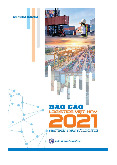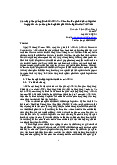



















Preview text:
ThankyoufordownloadingthisAMACOMeBook.
Signupforournewsletter,AMACOMBookAlert,andreceivespecial
offers,accesstofreesamples,andinfoonthelatestnewreleasesfrom
AMACOM,thebookpublishingdivisionofAmericanManagement Association.
Tosignup,visitourwebsite:www.amacombooks.org
PraiseforTheSupplyChainRevolution
Successfulcompaniesineveryindustrialsectorhavelongrecognizedthatcompetitiveadvantagecomes
notjustfromtheproductsorservicesthattheyofferbutfromthesupplychainsthatsupportthem.Inthis
easy-to-read and insightful book, the author explores the opportunities that exist for improving
profitabilitythroughsupplychainexcellenceandprovidespracticalguidanceonhowtoachievethatgoal.
—MartinChristopher,EmeritusProfessorofMarketing&Logistics,CranfieldSchoolofManagement,UK
TheIdealSupplyChainPrimerfortheTime-PressedCEOorGovernmentExecutive
Inclear,conciselanguageSumanSarkardemystifiesthecomplexitiesofsupplychainmanagement.The
key to his process is simplification. In a world of business books full of buzzwords and unnecessary
complications,thisisarefreshingapproach.Sarkarbreakssupplychainmanagementintoitscomponent
piecesandsuccinctlylaysouttherelationships.Ifyouaregettingfoggy,conflictingadvicefromstaffand
suppliers, as I frequently did in a career managing large organizations, you will find this short read welcomeclarification.
—RichardConnelly,HallofFame,FormerBudgetLeader,EnergyDirector,DefenseLogisticsAgency,
DepartmentofDefense,USA
WonderfulBookforSupplyChainandBusinessLeaders
Sumanhaswrittenawonderfulbookforsupplychainandbusinessleaders.Hehaspresentedexamples
thattellthestoryofthefundamentalsinamemorableway.Itdemonstratesthevalueofsupplychainin
deliveringburstsresults.Ihighlyrecommendhimtoanyoneleadingasupplychain.
—MaryAnneGale,RetiredVPofSupplyChain,Procter&Gamble
SolidAdviceforBusyLeaders
In this quick-read, rich with examples, Suman describes the what and why of supply chain
debottlenecking, providing timeless, tried and true advice on how to simplify and streamline supply
chainsinclearandeasilyunderstoodlanguage.Sumanendswiththeallimportantbusinessimperativeof
supplychainsprovidingacompetitiveedgetofirmsdoingthiswell.Especiallyrelevantinthisdigitalage
ofonlineshoppingandrapidproductinnovation.
—IsabelleKonstantinov,FormerProductSupplyAssociateDirector,Procter&Gamble THE SUPPLYCHAIN REVOLUTION
INNOVATIVESOURCINGANDLOGISTICSFORAFIERCELYCOMPETITIVE WORLD SUMANSARKAR
ThisbookisdedicatedtoSahanaRheaSarkarandNiharikaRamdevfortheirlove,encouragement,and support. ACKNOWLEDGMENTS
THE CONCEPTS IN THE BOOK WERE developed for my clients. They trusted me with their resources
and allowed me to experiment and develop the ideas that are shared in the book. I would like to
acknowledge my profound respect for my clients and their teams.
Two people made the book more readable—Charles Wallace and Alan Farnham. Charles was the
developmental editor and helped with structuring the content. He is an award-winning writer who excels
at translating complex concepts into easy-to-understand prose. His critique of each chapter was
enormously valuable, as he was able to point out where the logic did not flow and how to make technical
concepts simple to follow. Alan helped in the writing of this book. He made it accessible to a broader
audience by making the style less technical.
Several people reviewed each chapter for its content—Niharika Ramdev, Bill Shannon, Randy Hopkins,
and Isabelle Konstantinov. Their industry knowledge, expert understanding of the subjects, and
thoughtful critique helped to ensure that the content was accurate and of value to business readers.
A special thanks to Richard Connelly, who patiently reviewed the grammar in each chapter. His
understanding of the subject and mastery of the language helped make the book more readable.
Also, thanks are due to two marketing experts—Abigail Fisher and Bob Heyman. Abigail is a social
media marketing specialist who pushed me to develop a stronger social media presence. Bob is a digital
marketing expert who helped me think through how to use social media for selling books. Their input on
how to best market the book has been invaluable.
Finally, I would like to thank Michael Snell, agent, and Tim Burgard, editor at AMACOM, for trusting
and believing in this author. It is difficult for a first-time author to get an agent and a publisher. Without
Michael’s guidance and support, this book would not have been widely distributed. Tim provided great
suggestions on getting the book ready for publication. CONTENTS Introduction Steve Jobs and Supply Chain
Need for Supply Chain Revolution
Zara’s Supply Chain Advantage TJX’s Sourcing Advantage About the Author’s Work The Book Change Management PART 1
INCREASE REVENUE WITH HELP FROM SUPPLY CHAIN AND SOURCING
1 Drive Customer Satisfaction—Through Excellent Service
Benefiting From Excellent Service
Amazon’s Customer Service Advantage
Best Buy’s Challenges with Customer Service Increasing Service Levels
Tailoring Service Level by Customer Segment Developing a Competitive Edge
Getting Customers to Pay for Increased Service
Improving Service with the Help of Supply Chain
2 Boost Revenue with Supply Chain
The Airbus Supply Chain Advantage The Rise of Boeing Innovation and Supply Chain Airbus Enters the Market Boeing Plays Catch-Up Making Customization a Reality
Influence Upstream R&D Process
Segment Supply Chain by Demand Pattern Enabling Global Sourcing
Moving to Demand-Driven Planning
Boosting Revenue with Supply Chain
3 Amplify Alliance Performance with Sourcing
Alliances Can Make or Break a Company
Art of Alliance—Starbucks Style
Nokia’s Failure to Embrace Alliances
Sourcing’s Involvement in Alliances
Making Alliances Successful with Sourcing PART 2
REDUCE BUSINESS RISK THROUGH EFFICIENT OPERATIONS
4 Debottleneck the Supply Chain and Reduce Risk
Business Risks from Supply Chain
Benefits of Debottlenecking Supply Chain
Supply Chain Challenges at the Department of Defense (DoD) Supply Chain Complexity Reducing Nonmoving Inventory Simplifying Ordering Streamlining the Supply Chain Simplifying Delivery Simplifying Planning
Simplifying New Product Introduction
Simplifying Internal Organization Alignment
Simplifying Engagement with Suppliers
Fixing Supply Chain Bottlenecks
5 Increase Retail Success by Managing Store Investment
Store Investment and Retail Success Retail Industry Evolution Store Investment
Macy’s Challenges with Store Investment Costco’s Approach Evaluating Store Investment Reducing Store Costs Simplifying Store Development
Driving Retail Success with Sourcing PART 3
IMPROVE PROFITABILITY FROM AREAS THAT ARE CURRENTLY OUT OF SCOPE FOR SOURCING ORGANIZATIONS 6 Enhance Marketing Efficiency
Evolving Expectations from Marketing Marketing by Coca-Cola
Sourcing Organizations’ Challenges with Marketing
Lever Brothers’ vs. Procter & Gamble’s Approach to Marketing Efficiency
Measuring Marketing Performance Marketing—Complex Services Creative Agencies Media Buying Direct Marketing Market Research
Implementing Marketing Efficiency Program
7 Smart Real Estate Outsourcing Need for Smart Outsourcing
Facilities Outsourcing at Procter & Gamble
Cost Savings vs. Cost Reduction Trends
Facilities Outsourcing: Transitioning Toward Full Service
Failing to Achieve Cost Reductions Evolving Customer Expectations
Swinging of the Pendulum: Decline of IFM
Disrupting Industry—Short- and Long-Term Trends
Enabling Cost Reduction with Technology
Making Smart Outsourcing a Reality PART 4
DRIVE BUSINESS EXCELLENCE WITH HELP FROM SOURCING 8 Source Excellence
Excellence—Utopia or Reality?
Apple Helping AT&T Wireless Achieve Excellence Other Examples
Involving Sourcing in Excellence Defining Excellence 360 Triangulation Supplier Workshops Sourcing Excellent Solutions Making Excellence a Reality Conclusion HP’s Struggle
Private Equity Industry Challenges
Sustainable Competitive Advantage for Diversified Companies Improving Lives A Final Word Glossary Notes Index
Free Sample from Supply Chain Excellence About AMACOM THE SUPPLYCHAIN REVOLUTION INTRODUCTION
STEVEJOBSANDSUPPLYCHAIN
SteveJobs,afterhereturnedtoApplein1997,sethimselfthreegoalstoturnaroundthethen-struggling
company:ImproveApple’sproductpipeline,improveitsmarketing,andtransformitssupplychain.
Itssupplychain!WhywouldJobs—surelyoneofthecentury’smostvisionaryleaders—applyhimselfto somethingsomundane?
CEOshardlyever thinkaboutsupply chain,regardingthem ashavingabout thesameamount ofsex
appealasbroccoli.(Theyonlyviewonesubjectasbeingstilllesssexy:sourcing,theothersubjectofthis book.)
JobscaredaboutsupplychainsbecauseheknewthepriceApplewaspayingforhavingonethatwasso
shoddy and slipshod. He was able to imagine the competitive advantage the company would reap by
transformingitintosomethingbetter.
Atthetime,the companyhad onhand twoto threemonthsof supplierinventory andanothertwo to
three months of finished goods, forcing Apple to anticipate consumer wants four to six months ahead.
Jobsdecidedthatevenhewasnotsmartenoughtodothat.HedeputizedTimCooktorevampthesystem.
Cook reduced inventory from months to days. He closed factories and warehouses, using contract
manufacturers instead. He made long-term deals with suppliers to guarantee Apple’s supply of flash
memoryandotherkeycomponents.Heidentifiedandremovedbottlenecksinthesupplychain.Because
ofhisreforms,Applebecamesuperfast atnewproductdevelopmentandgettingnewproductsintothe
eagerhandsofconsumers.Assalesspiraledup,Jobs’sfocusonApple’ssupplychainwasvindicated.
Apple’sapproachtofixingthesupply chainwasaconventionalone.They tookthefirststepinfixing
the supply chain so it was not a roadblock to the company’s success. The field of supply chain has
expanded into new areas that are revolutionizing business. It is now able to help businesses drive
revenue,managecorporaterisk,driveexcellence,andcontinuetoreducecosts.
NEEDFORSUPPLYCHAINREVOLUTION
Despite examples such as this, most CEOs continue to ignore supply chain management and sourcing.
One result, not surprisingly, is that the state of the art in these two fields has not changed much in 20 years.
In fact, today’s practices are not much different from what they were in 1945 when war forced the
then-moderndisciplineofchainmanagementintobeing.
Simplyput,asupplychainexiststotakematerialfromsuppliers,moveitthroughmanufacturing,and
thendistributeittocustomersorendusers.InWWII,theenduserswerethearmyandthenavy,which
had to be supplied across multiple geographies through different transportation modes (land, sea, and air).
Just as well-functioning supply chains helped lead the United States to victory in WWII, so too did
bottleneckorotherwisepoorlyfunctioningchainsleadtodefeat.ItisnoexaggerationtosaythatHitler’s
setbacksatStalingradandinNorthAfricawereinparttheresultsofbreakdownsinsupply.
For decades after WWII, the military approach to supply chain management and sourcing served
private industry perfectly well. Now, however, it does not. Across a wide spectrum of industries, once-
potentcompaniesareintrouble:Walmart,IBM,Procter&Gamble(P&G),Pfizer,HP.Thebusinessmodel
ofthesecompaniesisstatic,relyingprimarilyonproductdifferentiationandglobalexpansion.Asproduct
differentiationandmarketexpansionopportunitiescontinuetobereduced,theyarefindingthemselvesat
acompetitivedisadvantage.Thisproblemcannotbeaddressedbyspendingmoremoneyonadvertisingor
buyingotherbusinesses.It isinoperationalareassuch assupplychainand sourcingthatacompetitive edgecanbefound.
So the bad news is that many famous business names now find themselves standing on a burning
platform.Thegoodnews?Theneedforchangecannolongerbeignored.
We areenteringa timeoftestingfor businessleaders:Those whocanevolvewill survive;thosewho
can’t won’t. In an era when management will need to exploit every competitive advantage it can find,
leaderswhocontinueto thinkofsupply chainsandsourcingonly intermsofcost reductionwillbe ata
seriousdisadvantage.Successwillcometoleaderswholearntoseethemaspotentialdriversofrevenue
growth,innovation,andriskreduction.
Thecontrastcouldnotbemoreclearbetweencompaniesthathaveturnedsourcingandsupplychains
intocompetitiveweaponsandthosethathavenot.
ZARA’SSUPPLYCHAINADVANTAGE
Atatimewhenmanymajorretailersareclosingstoresandseeingprofitsfade—Macy’s,BestBuy,Radio
Shack,theGap,Nordstrom,andSears,tonamebutafew—evolutionaryretailerZara—with6,777stores
in88countries—isthriving.
Compare Zara to, say, the Gap: By some estimates, it takes the Gap 9 to 12 months to get a new
clothing design into its stores. Imagine trying to predict fashion trends far in advance, then having to
procurethefabricanddothemanufacturing.Zaraestimatesitneedsonly10to15days—afeatitcredits
tohavingahighlyresponsive,demand-drivensupplychain.
Zara defies conventional wisdom about how supply chain should be run. It keeps almost half of its
productionin-house,leavesroomforextracapacity,andmanufacturesanddistributesproductsin small
batches.Thecompanymanagesdesign,warehousing,distribution,andlogisticsfunctionsin-house.Zara
offers a large variety of the latest designs quickly and in limited quantities, which allows them to
command a higher fraction of the full retail ticket price (an estimated 85%) compared to the industry average(60%to70%).
Its supply chain—that boring thing most CEOs cannot be bothered to think about—makes Zara the
mostvaluedcompanyintheretailspacewithamarketcapof$90billion.Itsfounder,AmancioOrtega,is
nowtherichestmaninEurope.(Foramomentin2015,hewastherichestmanintheworld,eclipsingBill
Gates.) Ortega’s view on clothes? They are perishable commodities like fruit: People change styles
frequently,dependingontheirwhimorsomefashiontrend.Accordingly,Ortegadesignedhissupplychain
toallowZaratogetanewdesigntocustomersinaslittleasaweekortwo.
Let’snowturntosourcing. TJX’SSOURCINGADVANTAGE
The TJX Companies, with a market valuation of close to $50 billion, owns brands including T.J. Maxx,
Marshalls,andHomeGoods.Itsshareholdershavebenefitedfrom18consecutiveyearsofearnings-per-
share growth. In its nearly four-decade history, it has had only one year of negative same-store sales.
Sourcing,thatotherboringarea,makesTJXacompanyotherbigretailersenvy.
Bernard Cammarata, who founded TJX in 1976, uses a unique approach to sourcing: TJX buys its
productsfrommajorbrandsatadiscountandthensellstheminitsstores.What’savailableinthestore
lastweekmaynotbeavailablethisweek.Itisalwaysatreasurehunt.Thishascreatedaloyalgroupof
customerswhokeepcomingbacktoseewhat’snew.TJXUniversitytrainsthecompany’sbuyersintheart
ofdealmaking.Theyareempoweredtomakemillionsofdollarsindealsthatinothercompanieswould
requireapprovalfromtopmanagement.Theyhaveturnedtraditionalretailsourcingonitsheadandhave therebycreatedvalue.
Examplesofothercompaniesthathaveachievedequallyimpressiveresultswillbefoundlaterinthis
book. In every case, management possessed two virtues: first, the imagination to see that supply chain
andsourcing,ifmanagedright,coulddelivergreaterbenefitsthanthecostsavingstraditionallyexpected
ofthem;andsecond,thecouragetoenactchange.
ABOUTTHEAUTHOR’SWORK
I personally have seen the results of these experiments: new supply and sourcing designs that drive
revenue,increaseinnovation,promoteexcellence,andreducerisk.
For the past 20 years, I have consulted with leading U.S.,European, and Asian corporations, first at
A.T.Kearney,andthen,startingeightyearsago,atmyownfirm.Ihaveworkedwithleadingcompaniesin
high tech, retail, pharma, financial services, and telecom, plus the Department of Defense and other
federalagenciesonsmallerprojects.Wearetalkingaboutthelargestbiotechcompany,theleadinghedge
fund,thelargestfacilitiesmanagementprovider,andtheleadingmultibrandretailer,justtonameafew.
Ipridemyselfontheabilitytodeliverlong-lastingbusinessresults,particularlyforcompanieswitha
strongculture,wherestandardapproachesmaynotwork.Someofmypastengagementshavegivenmea
close-up view of the challenges faced by sourcing and supply chain leaders. These professionals have
impressedme asbeing capableof doingfar morethan isexpected ofthem intheir traditionallylimited
roles.Companiescanusethemtowinmarketsandtodriveamazingbusinessresults.Itisadisserviceto
thinkofthemascapableonlyofcuttingcosts.
Thetransitionfromoldwaystonewwaysofthinkingisnevereasyforindividualsorfororganizations.
Yetitcanbedone.Anditmustbedoneifcompaniesaretocreatenewweaponsofadvantage. THEBOOK
Iexplainindetailhowcompaniesofallshapesandsizesareunboxingtheirsupplychainsandsourcing,
so as to achieve greater business value. Business value can be in the form of increased revenue, lower
businessrisk,improvedprofitability,andachievementofexcellence.
PART1—IncreaseRevenuewithHelpfromSupplyChainandSourcing
Chapter 1—Drive Customer Satisfaction—Through Excellent Service: As product
differentiation shrinks, some companies try to offer higher levels of service to win customers.
There is a cost attached to that. Supply chain organizations can drive customer satisfaction and
increaseprofitabilitybybalancingserviceandcostthroughsegmentationandincentives.
Chapter 2—Boost Revenue with Supply Chain: Supply chain can increase revenue by
enablingcustomizationorpersonalization,globalization,andimprovingresponsivenesstodemand.
Itplaysakeyroleinsuccessfullybringinginnovationtomarketandthensupportingrapidgrowth.
Chapter 3—Amplify Alliance Performance with Sourcing: Alliances are becoming critical
forbusinesssuccess.Asourcingorganizationwithexpertiseinmanagingsupplyrelationshipscan improvealliancesuccess.
PART2—ReduceBusinessRiskThroughEfficientOperations
Chapter 4—Debottleneck the Supply Chain and Reduce Risk: After years of neglect,
supply chains in many organizations are unable to deliver products and services. They have
becomehigh-riskareasthatneedtobeaddressedinasystematicwaybeforetheycancontribute
tobiggerobjectives.Simplificationiskeytodebottlenecksupplychainprocesses.
Chapter 5—Increase Retail Success by Managing Store Investment: Sourcing can help
ensurethatstrategicinvestmentsareexecutedinacommonsensefashion.Forexample,retailers
spend millions of dollars each year on opening new stores and remodeling old ones. A store’s
abilitytoremainprofitableintimesofchangingconsumerdemanddependsonitsoverheadcosts.
Sourcingcanreducecostsbyengaginggeneralcontractorsandtradesinnewanddifferentways.
Part 3—Improve Profitability from Areas That Are Currently Out of Scope for Sourcing Organizations
Chapter 6—Enhance Marketing Efficiency: Digital media have revolutionized marketing.
Sourcingteamscanuseanalyticaltoolstohelpmakemarketingcampaigns,includingdigital,more
efficient; they can help negotiate more favorable deals with marketing suppliers. Result: an
increaseinmarketingreturnoninvestment(ROI).
Chapter 7—Smart Real Estate Outsourcing: Companies have outsourced portions of their
business,suchasinformationtechnology(IT),payroll,facilitiesmanagement,andothers,withthe
hope of improving employee service and reducing cost. Most outsourcing arrangements have
failedto deliver onthis promise.Sourcing organizationscan help leadersidentify betterways to
benefit from relationships with suppliers, by using the latest analytic tools or by revising outsourcingagreements.
PART4—DriveBusinessExcellencewithHelpfromSourcing
Chapter 8—Source Excellence: With more than half the work at any company now being
performed by outside suppliers, management cannot hope to achieve excellence by ignoring
sourcing.Sourcingteamsneedtoplayanearlier,deeperroleinhelpingmanagementdefinewhat
kindofexcellenceisbeingsought,tofindthebestsupplierandnegotiatetherightterms. CHANGEMANAGEMENT
In terms of supply chain and sourcing, for organizations to become effective requires change from
leadership,R&D,salesandmarketing,andotherfunctionaldepartments.Inmyconsultingexperience,I
have found that functional organizations have great reluctance to take input from supply chain and
sourcing into account. They feel that they have the required expertise, and they are not sure if supply
chainandsourcingincentivesarealignedwiththeirbestinterests.
Itistruethatsupplychainandsourcingfolksarenotexpertsinfunctionalareas—norshouldtheybe
expectedtobe.Function-specificknowledge shouldcomefromthe functionalfolks.Nonetheless,supply
chain and sourcing teams can help these organizations find new solutions to their problems and can
negotiatedealsontheirbehalf.
Atthesametime,supplychainandsourcingteamshavetostepoutoftheircomfortzone—something easiersaidthandone.
Mostsupplychainandsourcingorganizationsarecomfortablewithtraditionalroles,astheyknowthe
expectations they must meet and understand what it takes to meet them. Many organizations call
themselves“worldclass”(whichimpliesthattheydonotneedtochangeandcannotcontributefurther).
Leadersoftheseorganizationsask,“Whyfixsomethingthatisn’tbroken?”
Whileforcingchangealwaysriskspushback,thefactisthatifcompaniesdonotattemptchange,some
competitorthatismoredeterminedandaggressivewillbreakopentheconstraintsandreapthebenefits.
Iamwritingaboutsupplychainmanagementandsourcingbecausetheyaremypassions.Iunderstand
thepowerof creativitythatwillbe unleashedifbusinessescan harnessthetalentthey alreadyhavein- house.
Clearly,leadership’slack ofappetite forchange isoneof thegreatest obstaclestoimproving today’s
generally poor state of supply chain practice. But there is nothing to be afraid of. Change can be
managed.Leadershipstartswithidentifyingtherootcausesofbottlenecksandothershortcomings,then
identifyingthebestfixes.
AlargechangeprogramcantakeyearstoimplementandcanrequireaCEO’sconstantchampioning.
Willyour CEOand your organizationstep up to thechallenge? I hope so.The payofffor wrestling with
these“boring”subjectsissimplytoogreattoignore.
Wewillstartthebookwithanareathatistraditionallythoughttobeoutofscopeforthesupplychain
organization: customer satisfaction. It’s an area that can be revolutionized, and the following chapter
providesatasteofhowcompaniescanimprovecustomerservicewiththehelpofsupplychain.
INCREASEREVENUEWITHHELPFROMSUPPLYCHAINAND SOURCING 1
DRIVECUSTOMERSATISFACTION—THROUGHEXCELLENT SERVICE
BENEFITINGFROMEXCELLENTSERVICE
WhatdocompaniessuchasAmazon,Chick-fil-A,Apple,Marriott,Starbucks,andAmericanExpresshave
incommon?Theyareallknownforexcellentcustomerservice.Customerstendtobeloyaltobusinesses
thathave great customerservice, and manyare willing to providereferrals to theirfriends, family, and
colleagues. Consumers will blindly purchase from these companies despite the fact that some of their
prices are higher than the competition’s. It is the belief that if the customers are not happy with the
productor service,thecompany willdo everythingit canto rectifythe problemquickly;customers will
nothavetowaitinlineforanhourtogettheproblemfixed.Customerserviceisnotonlyimportantfor
consumer-oriented businesses but also for businesses that service otherlarge corporations. Companies
embracecustomerserviceasawaytostandoutfromthecompetitionwhenproductdifferentiationislow orcustomersarefickle.
Mostpeopleassociatecustomerservicewiththeinteractionthattakesplacebetweenacompanyand
its customers, and not so much with supply chain. However, a company’s ability to provide excellent
customer service depends to a large extent on its operations—its ability to deliver a product or service
quicklyandaspromised, ortoreplaceor returnadefectiveproductquickly. Youwould notbehappyto
receiveafaxmachinefromanonlineretailerwhenyouorderedaprinter,andthenhavetowaitforfour
weeks toget the product replaced,despite the polite apologies ofthe customer service agent. You may
forgive the error the first time but would be unlikely to order from the store again if it happened repeatedly.
Forhappycustomers,consistencyandqualityofproductorservicedeliveryareimportant,andsupply
chain plays a critical role in making that happen. To be known for service, a company should have
intimate knowledge of customer needs, develop service models that are difficult for the competition to
match, and then find a way to get customers to pay for the better service. Involving the supply chain
organizationupfrontcanhelpidentifydifferentservicemodelsthatcanbeofferedtothecustomer.The
supply chain team can estimate the costs and effort associated with each. The sales team can then
negotiatethepricewiththecustomerinabusiness-to-businesssituation.
Customerserviceisateameffort.It’simportantthatfrontlinecolleaguesaresupportedbyawell-oiled
machinethatcanmeetorexceedcustomerexpectations.
AMAZON’SCUSTOMERSERVICEADVANTAGE
When Jeff Bezos founded Amazon in 1994, he vowed to become obsessed about delivering excellent
customerservice.ThesuccessofAmazonwasmainlyduetoBezos’sfocusonmeetingcustomerneedsin
uniquewaysthatweredifficulttoreplicatebycompetitors.Amazonhasreliedonandinvestedheavilyin
itssupplychaincapabilitiestosupportcustomerneeds.
Amazon has received both good and bad press, but one thing everyone agrees with is that Bezos’s
company has an outstanding customer service record. USA Today1 reported in 2015 that “for the sixth
consecutive year, Amazon.com has topped the customer service Hall of Fame. Less than 2% of survey
respondents reported a poor experience, and 59.4% reported excellent customer service, by far the
highestpercentageamongallcompaniesreviewed.”
Amazon’ssuperiorcustomerserviceisnoaccident;itcomesfromBezos’spersonalcommitment.Afew
quotesfromhimwillhelpyouunderstandhisphilosophy:2
“We’re not competitor obsessed, we’re customer obsessed. We start with what the customer
needs,andweworkbackwards.”
“Focusing on the customer makes a company more resilient.” Bezos famously brings an empty
chairtomeetingstorepresentthemostimportantpersonintheroom—“thecustomer.”
“If you make customers unhappy in the physical world, they might each tell six friends. If you
makecustomersunhappyontheInternet,theycaneachtell6,000.”
Bezosmakeshimselfpersonallyaccessibletocustomers.Heisknowntoforwardcustomercomplaintsto
theappropriate person in thecompany, adding a “?”in his email inorder to ensure aprompt response
andresolutiontotheproblem.Itishardtocompetewithacompanythathassuchoutstandingcustomer
service.EvenWalmartisstrugglingagainstAmazon’sonslaught.
Another example of Bezos’s unique focus on customer service is his concept and implementation of
AmazonPrime,3thecompany’sbreakthroughpromisetodeliverpackageswithintwodays.It’saservice
modelthatcompetitorsfinddifficulttoreplicate.Adecadeago,mostpackagestookaweekormoretoget
from door to door. Two-day shipment was so expensive that customers often preferred to visit a local
WalmartorTargetstoreiftheyneededsomethingquickly.
Amazon’sability to providetwo-day deliveryderives from afocus on itssupply chain, whichreduces
relianceonexpensiveUPSandFedExservices.Ithasanunparalleleddistributionnetworkandcontinues
to improve it every day. Amazon is now investing in robots in its distribution centers to handle peak
volume,expandingitstruckandairfleet,andeventinkeringwithnewideassuchasdeliverybydrones.
Amazonisalsoexpandingtheconceptofsame-daydeliveryinmanycitiesaswellastoyingwiththeidea
of Uber-type services for delivery of packages. To make last-mile deliveries cost-effective, Amazon is
openingwarehousesnearthemajorcities.Asof2016,Amazonisestimatedtohave180warehousesand
cannowdeliverpackageswithin-houseresourcesin30majormetropolitanareas.4
Though Prime has increased shipping cost, it has also proved another important point for Amazon:
Customersarewillingtopayforbetter,fasterservice.AmazonhasraisedthePrimemembershipfeefrom
$79 to $99 to pay for increased shipment cost, with minimal customer pushback—and membership continuestogrow.
Bezos has upended the traditional belief that increased customer service comes with an increased
cost. He has shown that customer service can be improved while remaining economical and, more
importantly,hasconvincedcustomerstopayforexpandedservices.
BESTBUY’SCHALLENGESWITHCUSTOMERSERVICE
Let’s look at another example: Best Buy. In 1966, Richard M. Schulze and a business partner opened
Sound of Music, an electronics store specializing in stereos, in St. Paul, Minnesota. They renamed the
storeBestBuyin1983toreflecttheirmarketingcampaign.Thecompanyexpandeditsproductofferings
toincludehomeappliancesandVCRs.Storesstartedtoplaceallstockonthesalesfloorratherthanina
stockroom,hadfewersalespeople,andprovidedmoreself-helpproductinformationforitscustomers.
Best Buy also did away with salespeople working on commission, in order to make the shopping
environmentfreeofthehigh-pressuretacticsusedinotherstores.In2004,ForbesmagazinenamedBest
Buy asits “Company of the Year.” The companygrew rapidly. It introduced the innovativeservice team
known as the Geek Squad5 and eliminated mail-in rebates to address negative customer feedback. An
increasingtrendtowardonlineshopping,however,begantoeroderevenuesandprofitsinthe2010s.
Best Buy’s biggest mistake seems to have been customer service failures. Customers routinely
complained about bad experiences with pushy and unhelpful store employees. The customer service
problem was compounded by Best Buy’s lack of supply chain capabilities. It failed to ship thousands of
preordered items that consumers planned to give as Christmas presents, and then failed to take
responsibilityforthefailure.
The company’s inventory management and reverse logistics systems for repair and return were
notoriously bad. A lot of product sat unsold in stores. In the face of declining revenue, management
aggressivelycutcostsandkeptoperationsasleanaspossible.Thisdroveprofitmarginshigherandkept
investorshappyin theshort run.Buta companycan neverachievegrowth bycuttingcosts. Tosurvive,
BestBuyneededtohavesustainedsalesgrowth,whichcouldonlybeachievedbyprovidinganimproved
customerexperience.Unfortunately,BestBuycontinuedtofocusonpricepromotionandexpansioninto
consumerdurablestoattractcustomersbutnotsomuchonimprovingcustomerservice. INCREASINGSERVICELEVELS
Manycompanies improvecustomerservice whenthey realizethatproduct differentiationis nothelping
themsellmoreproducts,buttheydon’t doitinafinanciallyprudentway.When Iransourcingprojects
formyclients,supplierswouldprovidefreeservicesasawaytosweetenthedeal.Overtime,itbecame
anacceptableindustrynorm.
Takethe exampleof thefacility management6 industry, whichprovides day-to-day employee services
suchasfoodpreparation,janitorial,andofficerelocation.Thesupplierschargetheiractualemployeecost
and add a management fee to account for their profit. The management fee is meant to ensure that
suppliersareprovidingoversightfortheiroperations.Ascompetitionbecamestiff,thesuppliersstarted
toputthefeeatriskbasedonperformance,andnowitisanacceptablenormthatthemanagementfee
will only be paid if the facility management supplier is doing everything right. This represented a drop
from assured to completely at-risk profit. The risk profile of the facility management suppliers has
increased, resulting in concern from their investors and customers about the sustainability of their offering.
Is a high service level necessarily bad? No. However, if your service levels do not vary by type of
customerorifyourcustomersarenotwillingtopayforbetterservice,youarepotentiallyoverservicing
your customers. Our experience across industries shows that companies seldom segment their service
offerings,therebyallowingalloftheircustomersaccesstothesamehighlevelofservice.Thisresultsin
significantcostincreaseswhencomparedtotheactualbenefitsfromtheincreasedlevelofservice.Why
doesthishappen?Costsarefrequentlynotvisibletocustomers,whoarenotofferedincentivestochoose
therightservicelevel.Theyendupaskingformoreservicewithoutconsideringtheservicecost.
Thesystemworksinasurprisinglysimilarwayinsidecorporationsaswell.Manycompanieshaveset
up their corporate functions, such as real estate, IT, HR, and procurement, as a shared services
organization.Thecentralizationeffortismadewiththehopethatitwillreducecoststhrougheconomies
of scale. Instead, many firms are finding the costs of shared services going through the roof instead of comingdown.
Forexample,asharedservicesorganizationatanaircraftcompanyincreasedcostsby20%despitea
decline in revenue. Why did this happen? It is hard to drive scale in the services area unless you
completely restructure work processes. Also, the customer organizations better managed their
expectations when they had to pay for their real estate or HR staff. They were okay with their offices
beingcleaned onceevery day.However, oncecentralized,the costs aresharedby a largerpool, andno
one challenges the need for an increased service level, such as getting the office cleaned immediately
afterasmallspill.Withoutadisincentive,customerswillcontinuetoaskforbetterserviceeveniftheydo
notneedit.Itissimilartoeveryoneorderingthemostexpensivedishonthemenuatadinnerwhenthe billgetssplitequally.
Tobeknownforservice,acompanyshouldhaveintimateknowledgeofcustomerneeds,theabilityto
provide service that is difficult for its competition to match, and a way to get customers to pay for the betterservice.
TAILORINGSERVICELEVELBYCUSTOMERSEGMENT
Mostcompanieslackanunderstandingofthecustomer’sneedforserviceindifferentcustomersegments.
Typically,onlyasmallgroupofcustomersrequiresahighlevelofservice.Whenfacedwithcompetition
or customer requests, companies tend to increase the service level for all of their customer segments
irrespectiveoftheirsizeorprofitability.
For example, at one corporate bank, a group of customers was demanding a higher standard of
service, whichincluded having a personal banker, an investment specialist, 24/7 customer support,and otherbenefits.
The bank faced a distinct risk of losing these customers if it failed to provide an increased level of
servicebecauseotherbankswerestartingtomarkettheirservicesaggressively.Toaddressthegrowing
demand, the bank provided the improved service to all of its customers and did not charge for it. This
resultedinasignificantcostincreaseandimpactedthebank’sprofitability.
Ouranalysis showed that onlythe segment of customerswho maintained large investmentswith the
bankwasaskingfortheincreasedlevelofservice.Thesecustomerswerealsowillingtopayextraforthe
better service, which would have offset the increased cost. All the other customers were not that
interestedintheimprovedservices,buttheywerewillingtousethemiftheywereprovidedatnoextra
cost. The bank would have managed its costs better if it had divided its customers into separate segments.
Ihave developed athree-step approach toseparate customers bysegment, definea menu of service
levels,andmatchservicelevelswithsegments.Itisagoodwaytothinkaboutservicelevelsthatcanbe offeredtocustomers.
FIRSTSTEP—CLASSIFYCUSTOMERSBYSEGMENT
Mostcompaniesclassifytheircustomersformarketingorsalesefforts.Theyusepsychographic(lifestyle)
or demographic segmentation to classify their customer base and identify the unique needs for
developing products or services. However, these classifications are not useful to identify what service
levels are needed to win in the market. Segmentation based on business metrics such as volume,
profitability, or the strategic nature of an account has shown to be more useful. For example, Amazon
Prime was targeted at customers who shop heavily online, irrespective of their lifestyle choices or demographics.
We were hired by a leading multibrand retailer to analyze its store delivery service costs. The costs
were increasing rapidly, and the client wanted to know how it could fix the problem without
compromising its operations. We found that its stores asked for increased delivery services from
distributorswithoutconsiderationtocost.Theincreasedlevelofdeliveryserviceincludeddailyservicing,
usingadedicatedtruck, anddeliveringbefore6a.m. Theservicerequestswere madetooptimizestore
laborbut didnot takeintoconsideration thecost ofdelivery. Itmade senseto providea higherlevel of
servicetopremiumlocationsandhigh-volumestores.Butextendingthesameservicetostoresinremote
locations createda significant cost burden. The distributor had tosend partially filled trucks to service
remotelocationstores,anditmadenofinancialsense.
To analyze the problem, our team used a simple framework to segment stores for the retailer by
definingtheirservicelevels(service-levelagreements,orSLAs)intheDallasmarket, whichwaschosen
as a test market. The retailer had 85 stores, and all of them received the same level of service. We
considered two important variables when determining the store segment. The first variable was store
profitabilityandvolume;thesecondvariablewasbrandcriticality(thedegreetowhichtheretailerwants




